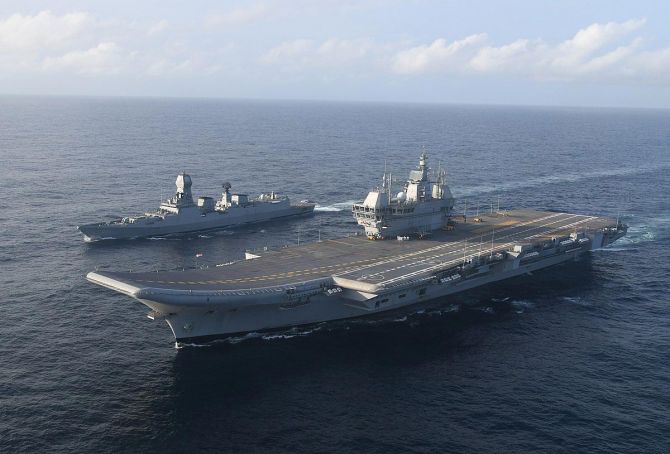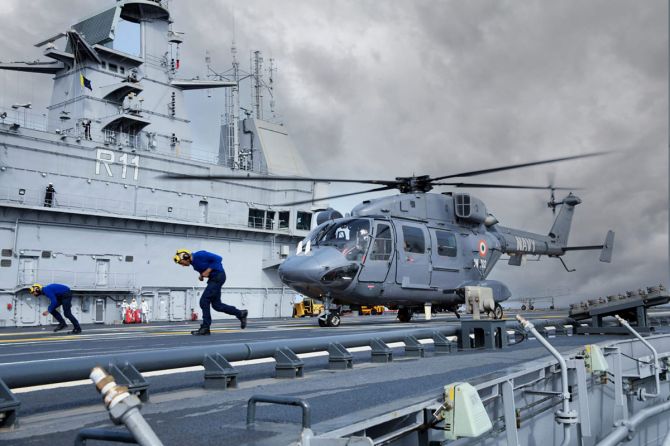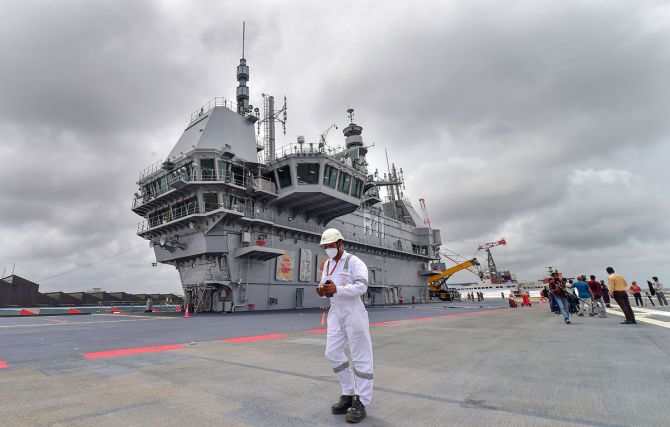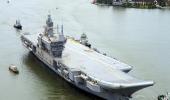In a record time of 13 years, the Indigenous Aircraft Carrier Vikrant is now ready for formal induction into the Indian Navy.

On a study tour with the students of the Defence Services Staff College a few years ago, we were taken around a large ship in the making which, at that stage had started to look like an aircraft carrier.
The enormity of the ship and the complexities of building it indigenously left us in awe of the project.
Many of us nay-sayers thought that it would be some time till we actually saw it sail.
But Cochin Shipyard Ltd, and all the other civil, military and international subsidiaries that were part of this project have surprised the nation and the world.
In a record time of 13 years, the ship is now ready for formal induction into the Indian Navy, a grand function for which has been organised at the docks in Kochi on Friday, September 2, 2022.
I spoke with Vice Admiral Biswajit Dasgupta AVSM, YSM, VSM, (Ati Vishisht Seva Medal, Yudh Seva Medal, Vishisht Seva Medal), the Flag Officer Commanding in Chief, Eastern Naval Command based at Vishakapatnam, who, in his quintessential way, had many things to say:
"The commissioning of Vikrant by the prime minister is steeped in significance. She is not just a reincarnation of her illustrious predecessor, but a multiple celebration of an India that is at the threshold of an exponential upward trajectory of self-reliance. But before that, let me give you a brief recap of her earlier avatar, the INS Vikrant.
"HMS Hercules, a 20,000-ton light carrier, the hull of which was laid at Vickers-Armstrong Harland and Wolff Shipyard in Britain in 1947, but was never commissioned into the Royal Navy, found her way to India in 1957 and was commissioned as INS Vikrant in 1961. Her pennant number, R 11, will be inherited by the new-born Vikrant in a few days from now.
"INS Vikrant taught the Indian Navy all about carrier-based aviation, right from helicopter operations to fixed wing fighter flying with all their associated intricacies, thrills and dangers. Fighter aircraft like the Alizes and Sea Hawks flew from her deck alongside the Alouettes and Seaking helicopters.
"In the years that she sailed, the Indian Navy picked up and perfected carrier operations. And, towards the end of her life, she was retrofitted with a ski-jump which allowed the Sea Harriers to operate as well."

Rear Admiral K Mohanan, AVSM (retd), was the last operational Commanding Officer of the erstwhile INS Vikrant before it was decommissioned. The INS Vikrant was commanded by Commander H S Rawat during its decommissioning years in 1996-1997. the rear admiral also has the rare distinction of serving on board the carrier in three different capacities in his tenure of 37 years in the Indian Navy.
I spoke to Rear Admiral Mohanan, below, about the role of the ship during war and his experiences of flying Alizes from the deck of the carrier during the 1971 War:
 "I was the youngest pilot in the squadron on the Vikrant flying the versatile fighter. Having joined the as a sub lieutenant in 1970, we had to immediately get into training for hostilities as the year progressed. I clearly remember my first landing on deck that year.
"I was the youngest pilot in the squadron on the Vikrant flying the versatile fighter. Having joined the as a sub lieutenant in 1970, we had to immediately get into training for hostilities as the year progressed. I clearly remember my first landing on deck that year.
"Having practised more than 100 times on the shore-based training facility, I flew deep into the ocean where the 'mother' was. She looked like a matchbox from 5,000 feet, and I wondered how I would ever be able to land on it. I was to do three or four practice touchdowns without the arrester hook first before I actually 'landed' on the deck.
"When they finally allowed me to lower my hook for the final landing, I was all excited. The landing itself was perfect and celebrations followed.
"I remember doing hundreds of sorties from the deck when we were deployed in the Bay of Bengal, just off Chittagong harbour in December 1971. The task for the ship was to carry out a naval blockade of the area to throttle the logistic supply to and from East Pakistan.
The aircraft on board the ship including the helicopters were used for a recce of the waters to search for mercantile and enemy naval traffic and stop them. After we found the ships, we would radio for the surface vessels to come and do the rest.
"Not enough intel was available on the deployment of the Pakistani air defence systems, especially their shore-based fighters. Therefore, we flew at 15 to 20 feet above the sea surface in the initial days.
"After a few days into the war, the IAF achieved complete air superiority and we were given a green signal to fly at whatever height we wished to. This was good since we could cover more area in our patrols and flying was less stressful."
"I cannot forget an incident during the war. A merchant ship chugged out of harbour heading out to sea and would not stop despite our radioed warnings. I decided to fire a single rocket first aiming at the water just ahead of the ship, but this did not deter it. As it built up speed, I decided to fire another two rockets aimed at its bridge, but, again, there was no reaction.
"I radioed for permission to use my bombs to destroy the vessel and received a go-ahead. Then I had second thoughts."

Deciding to give the ship one more chance, a bomb was dropped aimed just behind the ship.
"For missions like these, we carried the deadly 500 lb bombs instead of the usual depth charges thanks to the modification carried out by our technical guys. The bomb exploded where it was meant to.
"A mass of water rose out of the calm sea and the ship was obliterated from view for a while. I wondered if I had inadvertently hit it. Waiting for the visibility to clear, I got ready for a final dive attack to sink the ship.
"As I flew in nearer to get a better view, I saw that the ship had stopped and its crew were running on deck trying to get into life-rafts."
The Indian Navy had achieved its aim without destruction of the vessel or its civilian crew who were promptly taken to an Indian port and kept there till the war ended.
"We also had news that the US 7th Fleet was coming into our waters from the Malacca Straits and a large number of sorties were flown to detect the flotilla of ships which accompanied their aircraft carrier," the rear admiral recalls.
"The Americans never came into the Bay of Bengal; rather, they circumvented Sri Lanka and moved further south and therefore, were never a threat!"
Air Commodore Nitin Sathe retired from the Indian Air Force in February 2020 after a distinguished 35 year career.
The author of three books, you can read Air Commodore Sathe's earlier articles here.

Feature Presentation: Rajesh Alva/Rediff.com












 © 2025
© 2025